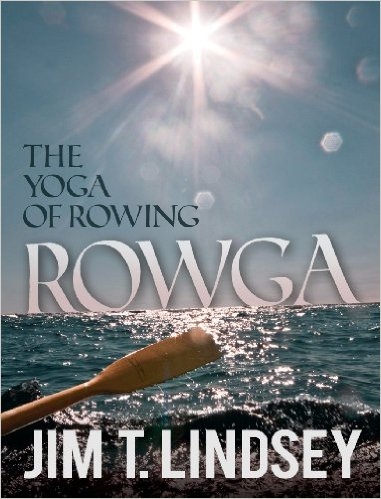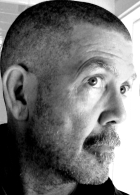 Every blogged book and author can teach us something about the process. Rowga, the Yoga of Rowing, is where Jim Lindsey poured out the immediate results of sessions of contemplative ocean rowing mixed with thirty years of Buddhist study and meditation.
Every blogged book and author can teach us something about the process. Rowga, the Yoga of Rowing, is where Jim Lindsey poured out the immediate results of sessions of contemplative ocean rowing mixed with thirty years of Buddhist study and meditation.
“I have loosely in mind all the topics I would like to cover; the blog frees me to address them as they arise,” explains Lindsey. “One day the weather prompts me to write about the uncertainty of life using the metaphor of navigating through fog. Another day a high wind and rough waves inspire an explanation of fear and fearlessness. The blog is served steaming hot and fresh in whatever order my hand comes to the ingredients.”
Lindsey’s book by the same name, which was published by SeaStorm Press in the fall of 2013 after a fundraising campaign, presents the posts “as a banquet—each dish refined to its essence and the presentation of dishes ordered to accord to the variability of an appetite,” Lindsey says.
Jim stopped blogging about the time he finished his book—2011. That’s not a choice recommended for those who want to promote their books long term, but many authors (and bloggers) give up on their blogs. They stop publishing posts and leave the blog to die a slow death.
There ‘s still something to learn from Lindsey’s book-blogging process. I interviewed him back in 2011 before the first edition of How to Blog a Book was released and while he was still blogging. This interview previously was provided to buyers as bonus content by Writer’s Digest Books.
Why did you begin blogging?
I began blogging on the advice of my sister Leigh Anne. Her company SeaStorm Press of Sebastopol, California, is handling the ebook version of A Travellers Guide for Lost Souls, my current fictional series. She understood the difficulties of finding time to write, hold a separate job, and at the same time promote Lost Souls.
She encouraged me to be spontaneous with Rowga (the blog), and to worry later about organizing it for publication, and I have found that a great release. I’m not composing. I just pour forth.
How did you choose your topic?
I didn’t really choose my topic; it chose me. I was recovering from severing a nerve in my left hand. I had a Taiwanese doctor of traditional Chinese medicine advise me to quit taking painkillers and resting so much and get out and rev myself up as a more natural way of setting the healing process in motion. I live by the north Atlantic. I had a little dinghy I kept after being forced for financial reasons to sell my sailboat. I took to rowing it every chance I got, both inside the harbour and outside. I discovered I was meditating naturally when I took to the oars. I liked it so much better than conventional meditation that I’ve never gone back.
What, if any, market research did you do before beginning your blog?
I did absolutely no market research. I knew Rowga would be of benefit and that opportunities to teach it would present themselves if I simply began putting the subject out there.
Did you think you were writing a book, did you plan on blogging a book or were you simply blogging on your topic?
I knew I was writing a book. I know the book is there in the blogs I have written already. I have only to download them and do the editing. I don’t believe I would write fiction this way. I find the process of writing fiction very private and don’t like to release material until it is polished. But Rowga, even as a diamond in the rough, wants to be seen from the very beginning.
How long did it take for you to gain blog readers, and can you pin point any certain event that created a tipping point when readership increased noticeably?
I don’t know how many people are reading the blog. I am getting a certain amount of enthusiastic response from people who want me to keep writing about Rowga and to begin offering programs that teach it. I have one speaking engagement already and will soon be putting together a traveling schedule.
One of my most constant and encouraging followers is the young traditional boatbuilder who constructed my dory, Thomas Woods of Wallace, Nova Scotia.
What did you do to drive traffic (readers) to your blog?
If there is any driving of readers to my blog being done, it is my sister, Leigh Anne, doing it. It’s all I can do to write about Rowga, work on recording the audio version of Lost Souls, and keep my day job. My girlfriend’s chief complaint is that I work too much and spend too little time with her.
[Here are just a few things Leigh Anne said she did to help Rowga, the blog, attract readers: built an entire website for the blog and the book, signed Jim up for Networked Blogs and linked the blog with Facebook, Twitter (after she created the Facebook page and the Twitter account), updated Jim’s LinkedIn account, and posts and links back to the blog on all three. She uses a tool to automate messages about the blog, the book and other interesting tidbits to followers and those she has Jim follow or “like.” She manages Jim’s social media accounts, sets up other online accounts to promote his work where she can converse with other online writers. She will leave short comments with other bloggers and with LinkedIn writing groups. When she does so, she links back to the blog. There, she comments on other authors’ material on those sites and others such as Scribd, Amazon, Goodreads, and Smashwords.]
What one or two things that you did would you attribute to your blogging success, and what advice would you give to writers wanting to blog a book (and build readership/platform while doing so)?
What I do to succeed in blogging is to choose something I am passionate about and explore it in the mornings after I wake up and before I go to work. I would recommend the same recipe for anyone interested in blogging as a way to write a book. Blogging lets you steal a few moments and still get a lot out of it. You just write like the devil and edit like an angel who couldn’t care less.
About the Author
 Jim Lindsey (@Jim_Lindsey) is a writer, actor, Buddhist, and former Texan living in Nova Scotia. His first book, In Lieu of Mecca, published by University of Pittsburgh Press, was runner-up for the United States Poetry Award. His second, The Difficult Days, translations of poems by Roberto Sosa of Honduras, came out with Princeton University Press. His novel The Flaw in the Fabric was nominated for the 2012 Global eBook Awards. He was a reporter for three Texas papers including the Dallas Morning News. He’s published short stories with various literary magazines including the Antioch Review. He has an M. A. in Creative Writing from Boston University and was a fellow at the Provincetown Fine Arts Workshop on Cape Cod. He began studying Tibetan Buddhism in California, where he lived on a sailboat and worked as a technical writer for major Silicon Valley companies. In 1995, he made a transcontinental move to the old fishing village of Prospect near Halifax. He’s now a a dual citizen of the U. S. and Canada. He teaches a contemplative discipline that involves ocean rowing, develops online courseware for cargo plane pilots.
Jim Lindsey (@Jim_Lindsey) is a writer, actor, Buddhist, and former Texan living in Nova Scotia. His first book, In Lieu of Mecca, published by University of Pittsburgh Press, was runner-up for the United States Poetry Award. His second, The Difficult Days, translations of poems by Roberto Sosa of Honduras, came out with Princeton University Press. His novel The Flaw in the Fabric was nominated for the 2012 Global eBook Awards. He was a reporter for three Texas papers including the Dallas Morning News. He’s published short stories with various literary magazines including the Antioch Review. He has an M. A. in Creative Writing from Boston University and was a fellow at the Provincetown Fine Arts Workshop on Cape Cod. He began studying Tibetan Buddhism in California, where he lived on a sailboat and worked as a technical writer for major Silicon Valley companies. In 1995, he made a transcontinental move to the old fishing village of Prospect near Halifax. He’s now a a dual citizen of the U. S. and Canada. He teaches a contemplative discipline that involves ocean rowing, develops online courseware for cargo plane pilots.

Jim, years ago I saw your sister Lynn in Texarkana he told me you were in Nova Scotia. when I heard about your book.The Flaw ln the fabric I managed to get a copy read it enjoyed it thought I might try to track you down. I guess the last time l saw u was in Boston in 1975.
Your old friend
Handsome Johnny.
I no longer have Jim’s contact information. In fact, I think I worked through his sister. You might do a google search or contact his publisher.